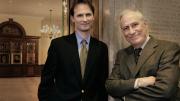Through centuries, Harvard’s libraries have amassed rich collections and unique holdings. But now budgetary pressures that have been building during the past decade, and intensified in the past year, threaten the ability of the world’s largest private library to collect works as broadly as it has in the past.
In an interview, University Library director and Pforzheimer University Professor Robert Darnton called the situation “a crisis in acquisitions.” As the number of books printed globally continues to increase—now standing at more than a million titles a year—the number Harvard can afford to collect has for years remained flat. The share of the world’s output of knowledge that Harvard acquires is therefore dwindling. (The library now holds 16.3 million volumes.) And even though technology has created new ways to store and present knowledge, such changes, at least for the time being, have merely added to the burden of libraries everywhere. A University report (https://www.provost.harvard.edu/reports/Library_Task_Force_Report.pdf) released in November therefore calls for the administrative, financial, and technological restructuring of Harvard’s library system, and for increased collaboration with other institutions.
“In the age of the electronic revolution,” Provost Steven E. Hyman said in an interview, “and in an age when far more is being produced, in terms of printed resources…than any one [institution] could collect, store, or preserve, we have to move from acquisition as the primary and central goal to access.” Critically, the access must be “in perpetuity, because we have not yet solved the problem of digital preservation.”
Hyman, who in February 2009 appointed a task force to study the University’s libraries, noted that some current challenges are shared by libraries everywhere, while others are unique to Harvard. Among the latter category, he points to the “excessively complex [administrative] structure of the libraries” (Harvard’s 73 physically separate libraries are run by more than 50 different entities), and “difficulties of decision-making, and the inefficient use of resources resulting therefrom,” as issues discussed in the recent report that had previously been raised among faculty members for a decade or more. The existing system—“library as labyrinth,” he says—makes it difficult to know what Harvard’s resources are, stands in the way of a rational collecting policy, and allows journal publishers to “exploit our divisions,” leading the libraries to spend more money than they should. Grossly inefficient use of internal resources is another consequence of extreme decentralization: an example cited by the task-force report took place in 2009, when “negotiations with one major scientific publisher engaged representatives of 24 separate libraries, apparently eating up hours and days of staff time—which frankly,” notes Hyman, “is a misallocation of Harvard’s scarce resources.”
“When you have a structure that is already at risk,” says Hyman, “and then subject it to extraordinary financial pressures,” as experienced in the past year, “you begin to see potentially real trouble.”
Harvard’s library, one of the four largest in the world and the only one that is not a deposit library (like the Library of Congress), is also unique among the four in that it collects in more than 350 languages and in all disciplines. “No one collects the way Harvard does,” says Darnton. “If we don’t do that collecting, who will?” He says the libraries’ responsibility is first and foremost to the students and faculty at Harvard, but “I think we have a national, even an international responsibility, to the whole world of learning. People look to Harvard to keep up a very high level of collecting the record of scholarship. So I view this responsibility as something that is haunting, really, because if we fail to keep up an adequate acquisitions rate, we are letting everyone down, not just the people at Harvard and not just this generation, but future generations as well.”
At its simplest, the problem facing many libraries is that budgets have only kept pace with inflation, while the cost of printed materials rises 9 percent a year. The budget of the Harvard College Library, which includes Widener as well as Lamont and Cabot libraries for undergraduates, is under particular strain, in part because it collects across the broadest array of languages, sciences, and other disciplines. That subjects it to the further strains of a weakening dollar (as foreign-language acquisitions become relatively more expensive) and relatively higher costs for retaining expert bibliographers to search for and buy the books that will keep up the strength of the collections.
“We were faced with a stark choice,” says Hyman. “If we subjected the whole system to across-the-board cuts, we would undoubtedly enfeeble the whole system.” Hyman and library leaders instead saw an opportunity to effect a fundamental reorganization, “so that we could have confidence that resources were being used as wisely as possible, so that we were aggregating our buying power, so that our internal systems could talk to each other, and so that we could collaborate externally.”
The task force report notes that Harvard’s decentralized system faces particular challenges in an environment that includes tighter budgets, shifting boundaries among academic disciplines, and the destabilizing influence of the digital revolution. In response, the report makes five core recommendations: adoption of a shared administrative structure; improvement to information technology systems; changes to funding models and cost-sharing among the libraries; enhanced coordination of materials collection and especially of access to those collections; and increased collaboration with other institutions. The report called for the immediate formation of a new group, now chaired by Divinity School professor of philosophy and theology David Lamberth, that will implement these recommendations.
Lamberth said in an interview that although the implementation group will consider the full range of options for consolidating library administrative functions, “going from 50 to a much smaller number of administrative organizations is probably meaningful, but going down to one may well be cutting off your nose to spite your face. Local autonomy of the schools and distinctive libraries is quite valuable,” he continues, “because there are so many different modes of providing service, and also cultures of knowledge and different kinds of materials.”
The risk of losing the expert bibliographers who choose the books Harvard buys is already a major issue among faculty members, who raised concerns during discussion of the libraries at a meeting of the Faculty of Arts and Sciences prior to the release of the task-force report. (Subsequently, in the letter to senior administrators, 100 faculty members called for more money for acquisitions.)
“A crucial, guiding idea” of the report, says Lamberth, is that “maintaining local expertise where it delivers excellence and real value is something we want to continue.” Adds Hyman, “I think intellectual decisions must be local. A molecular biologist in the medical school really can’t know what a Sanskrit scholar needs.” Administrative functions, on the other hand, “should be unified and benefit from economies of scale,” Hyman continues. “That means once local intellectual decisions are made, and are agreeable to a local budget, then acquisition, subscription, procurement, unpacking of boxes, cataloging, identification of appropriate storage, and preservation should be a central, unified, highly efficient function.”
One of the principal expected changes in funding and cost-sharing affects the Harvard Depository, where 45 percent of Harvard’s volumes are stored. Whenever a patron requests a book, the Harvard library that owns it is charged a fee of more than $2. The requesting library or school pays nothing. Libraries with large collections, such as the Harvard College Library, pay a lot under this system. A new system would distribute costs more equitably, and might even involve digitization of requested books upon their return to the depository.
A key point of the report is that information systems will need to be standardized and improved. When the online HOLLIS circulation system was developed in the late 1980s, data requirements were set by individual libraries, so that data are “not consistent across the collection,” says Lamberth. “That is an area that will have to be addressed, to allow us to more fully participate in outside consortial endeavors such as Borrow Direct,” the interlibrary loan system used by the rest of the Ivy League. John G. Palfrey VII, a professor and Ess Librarian at Harvard Law School, who chaired the task force’s technology working group, says that new technologies “need to become a driver of collaboration across the University’s many libraries and beyond,” rather than an inhibitor of working together. Harvard’s libraries, he says, faced with an historic moment of transformation, can serve researchers everywhere “more effectively and efficiently than we do today if we play our cards right with respect to technology integration and development.”
Collaborations that don’t require integration have begun already: for example, China’s national library is paying to digitize some of the rarest holdings in the Harvard Yenching Library. And Harvard is reportedly far along in talks with MIT (already a Harvard Depository client) on how the two institutions’ libraries could work together. (Cornell and Columbia’s libraries have announced a Mellon Foundation-funded plan to try sharing collections and the cost of digitization, for example. But collection-sharing will require improvements to Harvard’s library data systems.)
More students are using the libraries than ever, says Darnton, and not just from their rooms via computer: “their bodies are also present in the buildings.” The future is digital, he says—“That much we know. Meanwhile, we occupy what I refer to as a transitional phase…in which printed works and digital works must coexist and be mutually reinforcing. The digital future is exhilarating, and will enable us to open up the Harvard libraries and share our intellectual wealth. Part of me says, ‘Eureka!’ because it is the most exciting thing imaginable for a library. But then the other side of me crashes into a reality determined by the budget,” and the “disastrous last year” when acquisitions fell “precipitously.”









